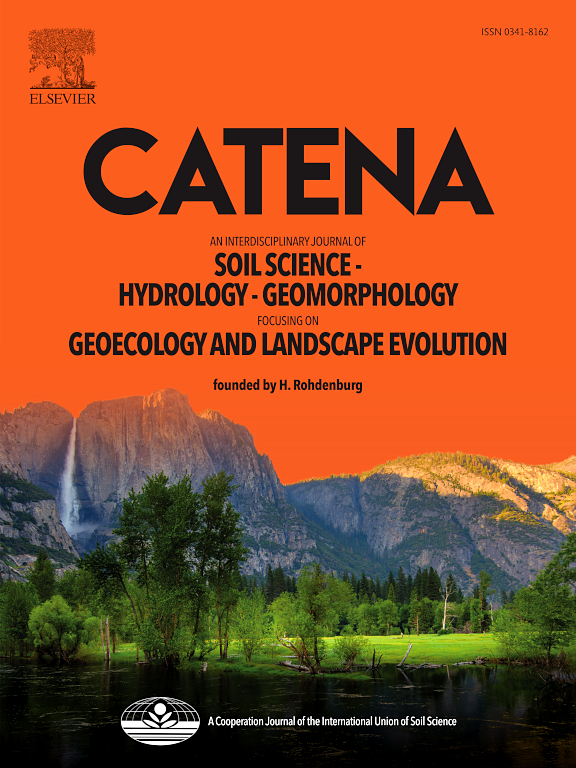Quantifying the effects of the soil erosion factors on water-eroded slopes
IF 5.4
1区 农林科学
Q1 GEOSCIENCES, MULTIDISCIPLINARY
引用次数: 0
Abstract
The factors influencing soil erosion are diverse and complex. However, a comprehensive comparative analysis of the various factors remains insufficient. By collecting, selecting and summarizing related studies across China, this study established a comprehensive dataset that includes runoff depth (R) and soil loss (SL) under various soil erosion factors (soil order, land use, vegetation coverage, slope length, slope gradient, and precipitation), to identify erosion pattern in different runoff plots based on rainfall events. Results showed that the average runoff depth (WR) and weighted average soil loss (WSL) of observed water erosion events in China are 20.10 mm and 331.92 t/km2, respectively. Semi-alfisols, amorphic soils, and pedocals reveal significantly higher R and SL. Forests prove most effective in mitigating soil and water loss, whereas grasslands and bare land exhibit similar runoff levels. Vegetation coverage of 40–60 % notably reduces both R and SL. R and SL fluctuate with the increase in slope length and slope gradient, but increase with growing precipitation. When the slope length exceeds 15 m and the gradient surpasses 25°, R and SL decrease significantly. Precipitation is the most significant factor impacting both R (contributing 58.70 %) and SL (contributing 30.25 %). This study underscores interactions among erosion factors and proposes multivariate linear regression models to predict R and SL based on these variables. It also contributes to clarifying the effects of erosion factors on slopes, providing a scientific basis for soil erosion modeling and control.
影响土壤侵蚀的因素多种多样,错综复杂。然而,对各种因素的综合比较分析仍然不足。本研究通过收集、筛选和总结中国各地的相关研究,建立了一个包括各种土壤侵蚀因素(土壤等级、土地利用、植被覆盖、坡长、坡度和降水)下的径流深度(R)和土壤流失量(SL)的综合数据集,以识别基于降雨事件的不同径流地块的水土流失模式。结果表明,中国观测到的水土流失事件的平均径流深度(WR)和加权平均土壤流失量(WSL)分别为 20.10 毫米和 331.92 吨/平方公里。半半质土、非晶质土和块根土的径流深度和加权平均土壤流失量明显更高。森林在减少水土流失方面最为有效,而草地和裸地的径流水平相近。植被覆盖率达到 40-60% 时,R 和 SL 都会明显减少。R和SL随着坡长和坡度的增加而波动,但随着降水量的增加而增加。当斜坡长度超过 15 米,坡度超过 25°时,R 和 SL 都会显著下降。降水量是影响 R(占 58.70%)和 SL(占 30.25%)的最主要因素。这项研究强调了侵蚀因素之间的相互作用,并根据这些变量提出了预测 R 和 SL 的多元线性回归模型。该研究还有助于阐明侵蚀因素对斜坡的影响,为土壤侵蚀建模和控制提供科学依据。
本文章由计算机程序翻译,如有差异,请以英文原文为准。
求助全文
约1分钟内获得全文
求助全文
来源期刊

Catena
环境科学-地球科学综合
CiteScore
10.50
自引率
9.70%
发文量
816
审稿时长
54 days
期刊介绍:
Catena publishes papers describing original field and laboratory investigations and reviews on geoecology and landscape evolution with emphasis on interdisciplinary aspects of soil science, hydrology and geomorphology. It aims to disseminate new knowledge and foster better understanding of the physical environment, of evolutionary sequences that have resulted in past and current landscapes, and of the natural processes that are likely to determine the fate of our terrestrial environment.
Papers within any one of the above topics are welcome provided they are of sufficiently wide interest and relevance.
 求助内容:
求助内容: 应助结果提醒方式:
应助结果提醒方式:


